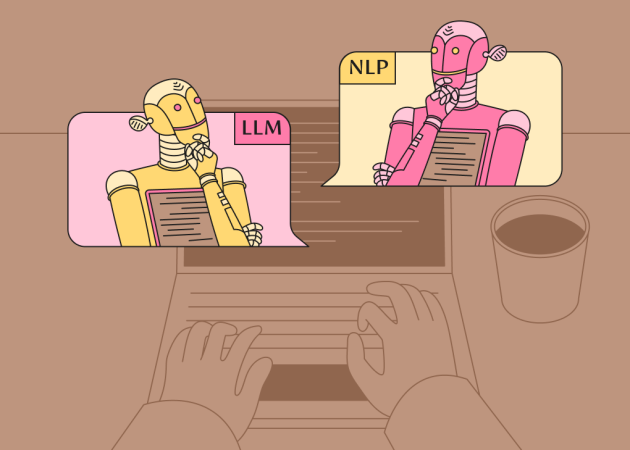
Top 9 AI Agents Use Cases to Enhance Customer Support
Contents
Contents
The rise of generative AI services is reshaping how organizations connect with their customers. In McKinsey’s 2024 global survey, AI adoption jumped to 72% across industries, and more than 80% of contact‑center leaders are investing in generative AI tools. Yet customer care remains a deeply human endeavor; nearly 79% of consumers believe humans will always have a role in customer service, and 20% prefer a human touch for complex issues. The challenge for leaders is to deliver efficient digital experiences without losing the trust, empathy, and personalization that only human agents can provide.
This article examines how modern AI agents address this challenge. We’ll trace the evolution from simple chatbots to advanced agents and leading AI agent solutions for customer support, and share practical insights into how a well-designed AI support agent can strengthen your team and business outcomes.
The Evolution from a Chatbot to Customer Support AI Agent
Early chatbots responded to simple FAQs with scripted answers. They were helpful for handling routine requests but fell short when conversations required context, reasoning, or action. Today’s AI agent customer support solutions integrate large-language models with decision-making and task execution capabilities. Rather than handing off issues to humans when a conversation veers off script, agentic systems can interpret intent, look up data across multiple systems, perform the necessary actions, such as issuing a refund, and communicate back to the customer within the same conversation.
Several factors have fuelled this evolution:
-
Maturing AI technology. Large language models are now capable of understanding unstructured text and speech. They enable agents to have fluid, human‑like dialogues rather than canned exchanges.
-
Integration of analytics and action. In traditional chatbots, analytics produced recommendations, but humans executed the action. Modern customer support AI agents tightly couple decision-making with execution, updating records, triggering workflows, or even initiating contact. Forrester frames this shift as moving from decision-making to action, positioning AI agents as a top emerging technology for 2025.
-
Rising customer expectations. Customers want fast answers and personalized experiences. A Forbes survey found that 69% of respondents prioritize a short response time and 67% expect companies to know them and personalize interactions. Traditional chatbots often fail to meet these needs, but AI agents can build the bridge.
- Operational pressure. Contact‑center leaders face increasing call volumes, attrition, and tight budgets. Automation and outsourcing are cited as the most frequently leveraged controls. AI agents reduce handle times and deflect routine tickets, freeing human agents for high‑touch interactions.
AI Agent Use Cases in Customer Support
AI agents for customer service take many forms depending on the problem being solved. Below, we explore a range of AI use cases in customer service, from fully autonomous issue resolution to real-time co-pilots, that demonstrate how agentic AI augments human capabilities, boosts efficiency, and creates more meaningful customer experiences.
Use Case 1. Autonomous End‑to‑End Issue Resolution
One of the most ambitious AI customer service use cases is the ability to resolve a customer’s problem without any human intervention. An autonomous agent collects all the necessary information, determines the best course of action, and carries it out while keeping the customer informed. Imagine a customer reporting a faulty product: the agent greets them, asks clarifying questions, pulls up order history, verifies warranty status, and initiates a replacement shipment. It updates the CRM, sends confirmation, and follows up post‑delivery to ensure satisfaction. The customer gets a quick resolution and feels heard; your team avoids repetitive tasks.
For instance, a European subsidiary of a global bank replaced its rules‑based chatbot with a generative AI system. Within seven weeks, the AI answered 20% more queries successfully than the older tool. A global construction-equipment company utilized a gen-AI agent to assist its call center in navigating thousands of pages of technical documentation, reducing resolution times from 125 minutes to seconds and saving customers $175,000–$349,000 per day in reduced downtime (McKinsey). These outcomes highlight how autonomous agents enhance first-contact resolution, speed, and cost efficiency while maintaining transparency for customers.
Use Case 2. Intelligent Ticket Triage & Routing
Among other common agentic AI use cases in customer service is intelligent ticket triage and routing. Not every query should be resolved autonomously. Many support centers still rely on rigid rules or manual triage that misdirects tickets and slows resolution. Intelligent routing harnesses AI to analyze incoming conversations, identify sentiment, urgency, and complexity, and match each issue to the right resource. For instance, an email or chat can be parsed by an agentic solution that assigns priority, suggests an answer or knowledge‑base article, and routes the case to a human when necessary. Over time, the system learns from outcomes and continuously refines its recommendations.
McKinsey’s analysis finds that AI-based support systems help agents resolve complex queries the first time, reducing care costs while enhancing the customer experience. One company that deployed AI for call‑volume forecasting and team scheduling saw forecast accuracy improve by seven percentage points, workload halve, and service levels rise by more than 10%. Intelligent routing ensures the right issues reach the right person quickly, freeing agents to spend less time categorizing tickets and more time solving them.

Use Case 3. Proactive Support & Personalized Engagement
Modern agentic AI enables companies to anticipate needs and act before friction arises. By analyzing past behaviors, real-time signals, and sentiment, AI can trigger targeted messages, personalized offers, or proactive fixes. Consider an e‑commerce customer repeatedly viewing a troubleshooting guide: the agent reaches out via chat, acknowledges the potential issue, and offers a solution. For subscription services, the agent monitors usage patterns and sends recommendations before renewal, reducing customer churn.
Consumers increasingly prefer proactive guidance to reactive support. A Forbes survey we mentioned earlier revealed that 78% of consumers are eager to interact with AI agents, despite 30% being unfamiliar with the term, and 59% believing AI will enhance customer service.
Use Case 4. Real‑Time Co‑Pilot for Human Agents
During a call or chat, the co‑pilot listens to the conversation, surfaces relevant knowledge‑base articles, and suggests the next best action. It drafts responses, performs sentiment analysis to gauge emotion, and reminds the agent to use de‑escalation techniques when necessary. After the interaction, it automatically summarizes the conversation, tags the ticket, and updates the CRM. Co-pilots enable human agents to focus on empathy and rapport, while the AI handles research and administrative tasks, resulting in faster resolutions and higher agent morale.
Use Case 5. Automated Knowledge Base & Workflow Automation
A reliable knowledge base is essential for efficient support; however, keeping it current and surfacing the right information at the right moment is labor-intensive. AI agents ingest new documents, summarize key points, tag them for findability, and deliver answers in context. When policies or product features change, the agent scans the relevant materials, extracts the changes, updates articles, and notifies the team.
During live interactions, it proposes the most relevant article for a query and adapts the suggestion as the conversation evolves. It can also trigger backend workflows, creating follow-up tasks, collecting missing details, or requesting approvals — so the knowledge doesn’t stop at an answer but drives action.
This is a low-risk, high-value entry point to generative AI. Teams see cleaner, more consistent content, faster onboarding, and fewer “swivel-chair” lookups. Learn more about the difference between AI agents and traditional automation tools in our recent article.
Use Case 6. Sentiment Analysis & Emotionally Intelligent Routing
People expect empathy from customer support, even when the first touchpoint is a bot. Sentiment analysis lets a customer support agent AI gauge tone and emotion in real time and adapt the experience. If language signals anger or frustration, the agent can alert a supervisor, switch into co-pilot mode, or route the case to a specialist trained in de-escalation. When sentiment is positive, it may offer personalized recommendations, loyalty rewards, or a faster self-service path.
By combining emotion detection with intelligent routing, teams keep empathy at the center while still using automation for speed. Clear escalation rules, transparent handoffs between AI and humans, and tone-aware responses protect the brand voice and build trust.
Use Case 7. AI‑Based Agent Training & Quality Assurance
High-quality support depends on ongoing training and thoughtful QA, both of which are hard to sustain at scale. AI reviews transcripts and recordings, spots patterns, and provides targeted feedback to agents. It highlights effective phrasing and de-escalation techniques, flags compliance gaps, and suggests improvements in real time.
Those insights feed agent-level coaching plans and lightweight micro-learning. The same engine can auto-generate call summaries, checklists, and updated talk tracks when products or policies change. The result is shorter ramp-up, more consistent outcomes across teams, and fewer preventable escalations, even as your service catalogue grows.
Use Case 8. Self‑Service & Virtual Assistants
Not every customer wants to speak with an agent; many prefer to resolve issues independently. Self-service portals and voice-enabled virtual assistants provide customers with immediate answers at any time of day. An AI voice agent for customer support can walk a customer through changing an address, checking an order status, or troubleshooting a basic problem. When the issue is resolved, the agent closes the case without ever involving a human. If the interaction becomes complex, it seamlessly transfers to a human with context.
Use Case 9. Predictive Personalization & Next Best Experience
While many AI agents focus on solving individual cases, some systems take a broader view of the customer journey. By integrating data across marketing, billing, service, and product usage, a predictive AI solution can anticipate when a customer is likely to churn, upsell, or simply need reassurance. In McKinsey’s research on the “next best experience,” analysts found that AI‑powered engines can enhance customer satisfaction by 15–20%, increase revenue by 5–8% and cut the cost to serve by 20–30%. These gains come from coordinating touchpoints: rather than bombarding customers with generic offers, the system sequences outreach based on propensity models, channel preferences, and lifetime value.
Predictive engines also drive retention and loyalty programs. A global payments processor built a machine-learning model that scored merchants on their likelihood of reducing business within seven days. It then grouped merchants by issue type and automatically triggered interventions, ranging from fee forgiveness to tailored product offers, to keep them engaged.
Challenges of Implementing AI Agents for Customer Support
Deploying AI agents is not as simple as plugging in a chatbot API. Leaders must navigate technological, organizational, and ethical obstacles. Below are some of the most common challenges we hear from clients and see echoed in industry research:
Integration and Orchestration Complexity
The first AI agent challenge in customer support is the complexity of integration and orchestration. Connecting agents to multiple systems (CRM, ERP, ticketing, payment gateways) can be technically challenging. Seamless integration is essential for a customer support representative AI agent to perform actions on behalf of the business. Without tight orchestration, agents risk becoming siloed chatbots that can’t execute.
Data Readiness and Quality
AI agents rely on large volumes of quality data, transcripts, knowledge articles, and CRM records to function effectively. Poor data quality leads to inaccurate responses, biased decision-making, and frustrated users. Organizations require robust data governance and privacy safeguards to train and fine-tune their models.
Risk Management and Governance
McKinsey’s findings highlight concerns about data privacy, safety, and security, as well as the business case for AI investments. Companies must implement guardrails to prevent hallucinations, ensure explainability, and comply with regulations. Human oversight should remain an integral part of the workflow, especially when agents make decisions that have financial or reputational implications.
Change Management and Skills
Adopting AI affects people and processes. According to McKinsey, two in three leaders consider upskilling and reskilling critical priorities, yet many contact centers struggle to free time for training. Successful deployments pair AI training with change‑management programs that align employees around the benefits and new ways of working.
Customer Trust and Transparency
Customers worry about empathy, privacy, and the loss of human connection. Organizations must clearly communicate when customers are interacting with an AI, make it easy to reach a human agent, and design escalation paths for emotionally sensitive situations.

Key Benefits of an AI Agent for Customer Support
Despite the challenges, the potential rewards are significant. Companies deploying AI-powered customer support agents get gains across multiple dimensions:
- Efficiency and cost savings. Generative AI solutions cut resolution times from hours to seconds in some industries. Intelligent forecasting and automation can reduce overtime and staffing expenses by more than 5%, as per McKinsey. By freeing humans to concentrate on higher‑value tasks, organizations can scale support without proportional headcount increases.
- Enhanced customer experience. AI agents offer 24/7 support across various channels, including chat, email, voice, and social media. Real-time analysis and recommendations enable agents to tailor interactions to individual needs, while proactive outreach addresses issues before they cause dissatisfaction. Fast, personalized responses and proactive engagement boost customer loyalty and satisfaction.
- Greater agility and insights. AI agents continuously learn from each interaction, improving accuracy and adapting to changing trends. With AI handling routine tasks, leaders gain richer analytics on customer sentiment, product issues, or agent performance. Automating mundane work frees teams to experiment with new services and business models, accelerating innovation.
- Compliance and auditability. Every action is logged end to end, creating a reliable audit trail and clear ownership. Built-in redaction and approvals protect sensitive data, so reviews move faster and risk drops. As compliance becomes routine, teams spend more time improving service, not chasing evidence.
- Multilingual reach and accessibility. Live translation preserves intent, not just words, while tone controls adapt phrasing to culture and context. Accessible flows guide users through the same steps, regardless of device or ability. The result is clearer understanding, fewer missteps, and smoother resolutions across regions.
- Elastic scale and resilience. Virtual agents absorb routine surges without queues ballooning, then hand off complex issues with full context. Humans pick up exactly where automation stops, avoiding restarts and repetition. This keeps response times steady through promotions, outages, and seasonal peaks.
- Brand voice control. Guardrails encode tone, terminology, and offer logic, so outputs start on-brand. Templates and snippets then carry those rules across channels and regions. As teams grow, messages stay consistent, and approvals shift from rewriting to quick verification.
- Employee experience and retention. Automation clears rote work and elevates problem-solving, which makes shifts feel meaningful. Real-time coaching turns mistakes into quick learning loops, reducing repeat errors. With less friction in daily work, morale improves, and people stay longer.
- Faster onboarding and consistency. In-flow guidance shows new hires what to say and do in real time. Shared playbooks and suggested replies anchor quality from the first week. As a result, proficiency arrives sooner, and service stays steady even as the team scales.
A Human‑First Approach to AI Agent Solutions for Customer Support
AI agents are not a silver bullet. They are powerful tools that, when deployed thoughtfully, can amplify the strengths of your people and processes. Many leaders still prioritize cost control while simultaneously striving to enhance customer satisfaction. Success lies in striking the right balance: using automation for efficiency, employing data and analytics for personalization, and empowering your human agents to deliver empathy and judgment.
At Beetroot, we help organizations navigate this journey. Our agentic AI services are designed to integrate seamlessly into your existing systems, uphold data privacy, and deliver measurable results. Whether you’re exploring how AI agent solutions for customer support can simplify your support workflows or are ready to build a custom implementation, we’re here to co‑create solutions that put your customers and team first.
FAQs
What is the main difference between an AI agent and a chatbot in customer support?
A chatbot follows scripted flows and typically handles only simple queries. In turn, an AI agent combines understanding, reasoning, and action. It can interpret context, pull information from disparate systems, perform tasks such as issuing refunds or updating records, and learn from interactions.
Will AI agents completely replace human support teams?
No, AI agents will not replace human support teams. They excel at routine tasks such as retrieving context, drafting replies, and executing straightforward actions, while people provide empathy, nuanced judgment, and the ability to navigate ambiguity. The strongest support models blend both, with AI accelerating the basics and humans building trust, managing emotions, and resolving the complex edge cases that define great service.
How do AI agents handle angry or emotionally complex customers?
Advanced agents perform sentiment analysis to gauge tone and emotion. When they detect frustration or sensitive topics, they can alert a human agent or switch the conversation to a co‑pilot mode that guides the human with de‑escalation tips.
Is it expensive to implement AI agents for customer service?
Implementation costs vary by scope and starting point, so plan for licensing, data preparation, system integration, security reviews, and change management, rather than treating them as a single line item. The upside usually comes from deflecting routine volume, shortening handle times, improving forecast accuracy, and reducing overtime, together lowering the day-to-day cost of support. The most pragmatic path is to start with a small, high-impact pilot such as knowledge-base automation, define clear success metrics, validate ROI, and then scale once the approach is proven.
Can a customer support AI agent integrate with CRM or ticketing systems?
Yes. Integration is essential for any AI agent solutions for customer support to perform meaningful actions. Modern agents utilize APIs to read and write data in CRM systems, ticketing platforms, and other business applications. Integration typically enables features such as automatic ticket creation, workflow triggers, and end-to-end issue resolution.
Subscribe to blog updates
Get the best new articles in your inbox. Get the lastest content first.
Recent articles from our magazine
Contact Us
Find out how we can help extend your tech team for sustainable growth.







